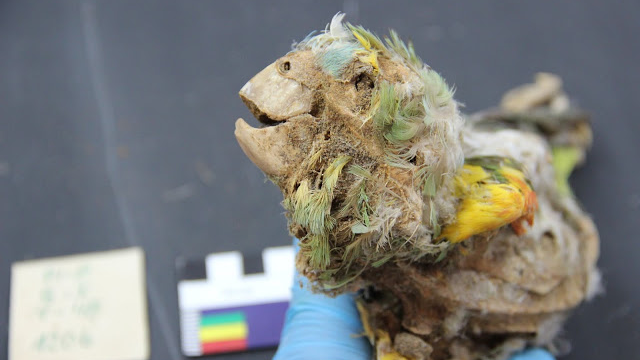It is not a journey that they have taken as the crow flies.
Discovered at five archaeological sites in the Atacama Desert, in northern Chile, around twenty mummified parrots and parakeets of six different species still stand out today with the liveliness of their down.
Preserved in the various museums of the region, these birds lived in the southern oases of the pre-Columbian culture of Tiahuanaco (or Tiwanaku), between 1100 and 1450, a geographical area from which they are quite exogenous.
According to a study published by a Pan-American team, these mummies attest to the existence of a perennial commercial network which linked - before the emergence of the Inca Empire - the western sphere of the Andes Cordillera to its eastern sphere.
Read also: A rare Inca offering chest found intact at the bottom of Lake Titicaca
At the origin of this genetic-archaeozoological research, scientists looked at the circulation of feathers in pre-Columbian America, a flow that was poorly identified despite the certain popularity enjoyed by these colorful and exotic ornaments.
Symbols of wealth and power, they were displayed in impressive plumes or on prestigious clothing.
"
Feathers are appreciated in all the Americas, they are found in graves found in aristocratic graves, but we did not know how they got there, what routes and what networks they took,
" explained José M. Capriles. , assistant professor of anthropology, in a statement from his Pennsylvania State University.
Published Monday in the scientific journal
Proceedings of the National Academy of Sciences,
the results of the analysis of 27 mummified parrots from Atacama have made it possible to identify their sites of origin, in the eastern Amazon, and to trace, by extension, their route to one of the harshest deserts in South America.
Imported from the Amazon, on the other side of the Andes, parrots were appreciated and exploited for their plumage.
Calogero Santoro / Universidad de Tarapaca / Jose Capriles / Penn State
Not every bird would do.
Among the myriad of birds populating the Amazonian space, the taste of the pre-Columbian communities of Atacama was preferably for the scarlet, canary and cerulean feathers of the great scarlet
macaw
(
Ara macao
).
Along with at least five other species, these parrots were the object of a trade articulated "
on a vast network of exchange extended over more than 500 km towards the tropics of the east of the Amazon
", in the words of l 'study.
These long-term crossings undertaken in the middle of the steep paths of the Andes by llama caravans were far from easy and, no doubt, must have required advanced logistical preparation.
"
That live birds were able to cross the Andes at an altitude of more than 3000 km is impressive
," José M. Capriles was excited.
They had to be transported across immense steppes, in cold weather and over difficult terrain to Atacama.
While keeping them alive
”.
Not an easy task to believe the researcher who recalls that “
llamas are not the best beasts of burden.
"
Read also: The Huaris, this pre-Inca civilization which based its domination on beer
If the ordeals of these Andean expeditions perhaps gave pre-Columbian merchants a few white hairs, the parrots literally lost their feathers on arrival.
Very far from being treated with much consideration - during their lifetime anyway - these Amazonian birds were plucked as quickly as possible, then throughout their breeding east of the Andes.
“
Some of these birds did not have happy lives
,” said José M. Capriles.
They were kept to produce feathers, which were plucked from them as soon as they sprouted.
The scientists in any case managed to establish that they were fed a "
diet rich in corn-based foods fertilized by seabird guano
", similar to what then formed the basis of the diet of the Atacama oasis, where they learned to live.
Eviscerated and mummified after death, some of the birds examined were even staged, their wings spread - immortalized in perpetual flight - or beaks wide open, while others were wrapped in cloth.
The sign of a singular relationship that the inhabitants maintained with their exotic birds?
"
We have absolutely no idea why they were mummified like that
", dismissed the Pennsylvanian anthropologist from the outset, pointing to the difficulty of finding the archaeological context of these mummies, which are for the most part poorly documented second-hand discoveries. The preferred hypothesis remains, however, that of a funerary provenance, where we are already used to sometimes finding parrot feathers. The presence of such a bird - perceived as the production unit of a luxury good with high symbolic value - was therefore to “
unambiguously signal the opulence
” of the occupants of the burial with which it was associated. As the study finally points out, these displays of wealth of animal origin should also weigh “
in a context of emerging inter-community competition
”. It did not in any way prevent the culture of Tiahuanaco from being plucked in its turn, around the middle of the 15th century, by the nascent Inca Empire.

